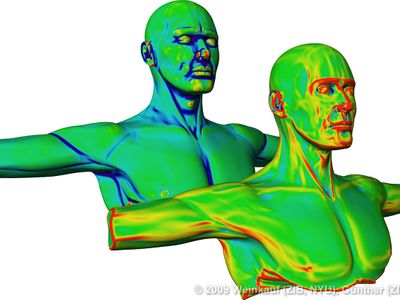- Computer graphics
- Information visualization
- Scientific visualization
- Interaction programming
DH2320 Introduction to Visualization and Computer Graphics 6.0 credits
This course will be discontinued.
Last planned examination: Spring 2027
Decision to discontinue this course:
The course will be discontinued at the end of Spring 2027 according to the faculty board's decision: J-2024-1027.
Decision date: 2024-05-14
The course is offered for the last time in Spring 2025. The last opportunity to take an examination in the course is in Spring 2027.
Students who have not completed the course can be examined within the framework of course DD2258 up to and including Spring 2027.

This course covers fundamentals in visualization and computer graphics. The goal is to understand the following concepts:
- Linear transformations and homogeneous coordinates
- Spatial data structures and grids
- Interpolation in 2D and 3D grids
- Modeling meshes
- Shading and color including color models and perception
- Rendering: rasterization (projection, clipping, visibility)
- Rendering: raytracing
- Raycasting a volume
- All-purpose visualization methods and their best practices
The course includes both theory and practical aspects. A number of tutorials will deepen the understanding of the course content using theoretical and practical assignments.
We have another version of this course that provides a bit more content in image and video processing. It awards 7.5hp and is graded A-F. See DD2258.
It is the basis for many other visualization and graphics related courses at KTH:
Information per course offering
Choose semester and course offering to see current information and more about the course, such as course syllabus, study period, and application information.
Information for Spring 2026 visgra26 programme students
- Course location
KTH Campus
- Duration
- 13 Jan 2026 - 13 Mar 2026
- Periods
Spring 2026: P3 (6 hp)
- Pace of study
50%
- Application code
60554
- Form of study
Normal Daytime
- Language of instruction
English
- Course memo
- Course memo is not published
- Number of places
Places are not limited
- Target group
- Open for students from year 3 and for students admitted to a master's programme as long as it can be included in your programme.
- Planned modular schedule
- [object Object]
- Schedule
Contact
Course syllabus as PDF
Please note: all information from the Course syllabus is available on this page in an accessible format.
Course syllabus DH2320 (Spring 2024–)Content and learning outcomes
Course contents
Intended learning outcomes
The students should after the course be able to
- explain fundamental concepts within computer graphics such as geometrical transformations, illumination models, removal of hidden surfaces and rendering
- explain the ideas in some fundamental algorithms for computer graphics and to some extent be able to compare and evaluate them
- explain and apply fundamental principles within interaction programming
- explain and understand fundamental concepts within information visualization and scientific visualization.
Literature and preparations
Specific prerequisites
Single course students: 90 university credits including 45 university credits in Mathematics and/or Information Technology and the courses SF1604 Linear algebra, SF1625 Calculus in one variable, SF1626 Calculus in several variables, SF1901 Probability theory and statistics, DD1337 Programming and DD1338 Algorithms and Data Structures or equivalent.
Literature
Examination and completion
Grading scale
Examination
- TEN1 - Examination, 3.0 credits, grading scale: P, F
- LAB1 - Laboratory Work, 3.0 credits, grading scale: P, F
Based on recommendation from KTH’s coordinator for disabilities, the examiner will decide how to adapt an examination for students with documented disability.
The examiner may apply another examination format when re-examining individual students.
If the course is discontinued, students may request to be examined during the following two academic years.
Examiner
Ethical approach
- All members of a group are responsible for the group's work.
- In any assessment, every student shall honestly disclose any help received and sources used.
- In an oral assessment, every student shall be able to present and answer questions about the entire assignment and solution.
Further information
Course room in Canvas
Offered by
Main field of study
Education cycle
Supplementary information
In this course, the EECS code of honor applies, see:
http://www.kth.se/en/eecs/utbildning/hederskodex